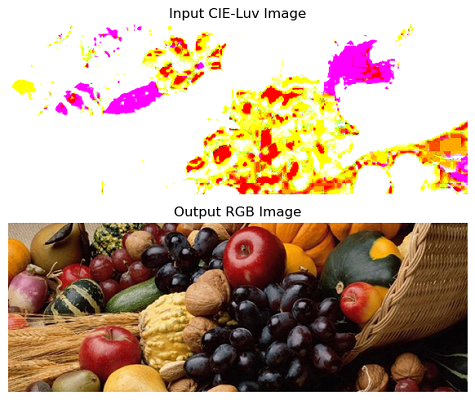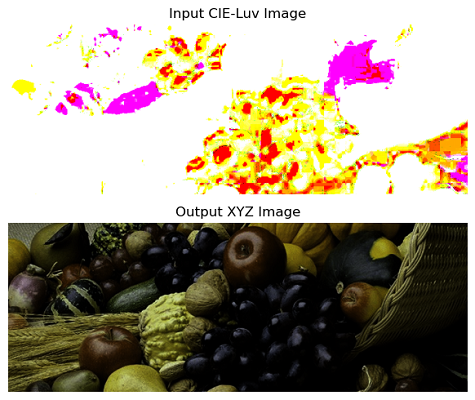
- Scikit Image – Introduction
- Scikit Image - Image Processing
- Scikit Image - Numpy Images
- Scikit Image - Image datatypes
- Scikit Image - Using Plugins
- Scikit Image - Image Handlings
- Scikit Image - Reading Images
- Scikit Image - Writing Images
- Scikit Image - Displaying Images
- Scikit Image - Image Collections
- Scikit Image - Image Stack
- Scikit Image - Multi Image
- Scikit Image - Data Visualization
- Scikit Image - Using Matplotlib
- Scikit Image - Using Ploty
- Scikit Image - Using Mayavi
- Scikit Image - Using Napari
- Scikit Image - Color Manipulation
- Scikit Image - Alpha Channel
- Scikit Image - Conversion b/w Color & Gray Values
- Scikit Image - Conversion b/w RGB & HSV
- Scikit Image - Conversion to CIE-LAB Color Space
- Scikit Image - Conversion from CIE-LAB Color Space
- Scikit Image - Conversion to luv Color Space
- Scikit Image - Conversion from luv Color Space
- Scikit Image - Image Inversion
- Scikit Image - Painting Images with Labels
- Scikit Image - Contrast & Exposure
- Scikit Image - Contrast
- Scikit Image - Contrast enhancement
- Scikit Image - Exposure
- Scikit Image - Histogram Matching
- Scikit Image - Histogram Equalization
- Scikit Image - Local Histogram Equalization
- Scikit Image - Tinting gray-scale images
- Scikit Image - Image Transformation
- Scikit Image - Scaling an image
- Scikit Image - Rotating an Image
- Scikit Image - Warping an Image
- Scikit Image - Affine Transform
- Scikit Image - Piecewise Affine Transform
- Scikit Image - ProjectiveTransform
- Scikit Image - EuclideanTransform
- Scikit Image - Radon Transform
- Scikit Image - Line Hough Transform
- Scikit Image - Probabilistic Hough Transform
- Scikit Image - Circular Hough Transforms
- Scikit Image - Elliptical Hough Transforms
- Scikit Image - Polynomial Transform
- Scikit Image - Image Pyramids
- Scikit Image - Pyramid Gaussian Transform
- Scikit Image - Pyramid Laplacian Transform
- Scikit Image - Swirl Transform
- Scikit Image - Morphological Operations
- Scikit Image - Erosion
- Scikit Image - Dilation
- Scikit Image - Black & White Tophat Morphologies
- Scikit Image - Convex Hull
- Scikit Image - Generating footprints
- Scikit Image - Isotopic Dilation & Erosion
- Scikit Image - Isotopic Closing & Opening of an Image
- Scikit Image - Skelitonizing an Image
- Scikit Image - Morphological Thinning
- Scikit Image - Masking an image
- Scikit Image - Area Closing & Opening of an Image
- Scikit Image - Diameter Closing & Opening of an Image
- Scikit Image - Morphological reconstruction of an Image
- Scikit Image - Finding local Maxima
- Scikit Image - Finding local Minima
- Scikit Image - Removing Small Holes from an Image
- Scikit Image - Removing Small Objects from an Image
- Scikit Image - Filters
- Scikit Image - Image Filters
- Scikit Image - Median Filter
- Scikit Image - Mean Filters
- Scikit Image - Morphological gray-level Filters
- Scikit Image - Gabor Filter
- Scikit Image - Gaussian Filter
- Scikit Image - Butterworth Filter
- Scikit Image - Frangi Filter
- Scikit Image - Hessian Filter
- Scikit Image - Meijering Neuriteness Filter
- Scikit Image - Sato Filter
- Scikit Image - Sobel Filter
- Scikit Image - Farid Filter
- Scikit Image - Scharr Filter
- Scikit Image - Unsharp Mask Filter
- Scikit Image - Roberts Cross Operator
- Scikit Image - Lapalace Operator
- Scikit Image - Window Functions With Images
- Scikit Image - Thresholding
- Scikit Image - Applying Threshold
- Scikit Image - Otsu Thresholding
- Scikit Image - Local thresholding
- Scikit Image - Hysteresis Thresholding
- Scikit Image - Li thresholding
- Scikit Image - Multi-Otsu Thresholding
- Scikit Image - Niblack and Sauvola Thresholding
- Scikit Image - Restoring Images
- Scikit Image - Rolling-ball Algorithm
- Scikit Image - Denoising an Image
- Scikit Image - Wavelet Denoising
- Scikit Image - Non-local means denoising for preserving textures
- Scikit Image - Calibrating Denoisers Using J-Invariance
- Scikit Image - Total Variation Denoising
- Scikit Image - Shift-invariant wavelet denoising
- Scikit Image - Image Deconvolution
- Scikit Image - Richardson-Lucy Deconvolution
- Scikit Image - Recover the original from a wrapped phase image
- Scikit Image - Image Inpainting
- Scikit Image - Registering Images
- Scikit Image - Image Registration
- Scikit Image - Masked Normalized Cross-Correlation
- Scikit Image - Registration using optical flow
- Scikit Image - Assemble images with simple image stitching
- Scikit Image - Registration using Polar and Log-Polar
- Scikit Image - Feature Detection
- Scikit Image - Dense DAISY Feature Description
- Scikit Image - Histogram of Oriented Gradients
- Scikit Image - Template Matching
- Scikit Image - CENSURE Feature Detector
- Scikit Image - BRIEF Binary Descriptor
- Scikit Image - SIFT Feature Detector and Descriptor Extractor
- Scikit Image - GLCM Texture Features
- Scikit Image - Shape Index
- Scikit Image - Sliding Window Histogram
- Scikit Image - Finding Contour
- Scikit Image - Texture Classification Using Local Binary Pattern
- Scikit Image - Texture Classification Using Multi-Block Local Binary Pattern
- Scikit Image - Active Contour Model
- Scikit Image - Canny Edge Detection
- Scikit Image - Marching Cubes
- Scikit Image - Foerstner Corner Detection
- Scikit Image - Harris Corner Detection
- Scikit Image - Extracting FAST Corners
- Scikit Image - Shi-Tomasi Corner Detection
- Scikit Image - Haar Like Feature Detection
- Scikit Image - Haar Feature detection of coordinates
- Scikit Image - Hessian matrix
- Scikit Image - ORB feature Detection
- Scikit Image - Additional Concepts
- Scikit Image - Render text onto an image
- Scikit Image - Face detection using a cascade classifier
- Scikit Image - Face classification using Haar-like feature descriptor
- Scikit Image - Visual image comparison
- Scikit Image - Exploring Region Properties With Pandas
Scikit Image - Conversion from luv colorspace
The Luv color space also referred to as CIELUV, is a color space defined by the International Commission on Illumination (abbreviated CIE) in 1976. It is a transformation of the CIE XYZ color space and is designed to achieve perceptual uniformity. It is commonly used in various applications, including computer graphics and color-related tasks in image processing.
In the scikit-image library, you can use the CIELUV color space through the color.luv2rgb() and color.luv2xyz() functions. These functions allow you to convert images in the CIELUV color space to the RGB, and XYZ color spaces.
Converting CIE-Luv image to RGB image
The skimage.color.rgb() method is used to perform the conversion of an image in CIE-Luv color space to the RGB color space. Using the luv2xyz() and xyz2rgb() method.
Syntax
Following is the syntax of this function −
skimage.color.luv2rgb(luv, *, channel_axis=-1)
Parameters
- luv(array_like): The input image in CIE-Luv color space. The shape of the array should be at least 2-D with the last dimension having a size of 3, representing the CIE-Luv channels.
- channel_axis: This parameter indicates which axis of the array corresponds to the channels. By default, it is set to -1, which corresponds to the last axis.
Return Value
The method returns a ndarray representing the output image in RGB color space. The dimensions of the output array are the same as the input array.
Exception
It will raise the ValueError, if the lab input is not at least 2-D with a shape of (..., 3, ...), indicating the presence of the three channels.
Example
The following example demonstrates the conversion of an image from CIE-Luv color space image to an image in RGB color space using color.luv2rgb() method.
import numpy as np
from skimage import color, io
import matplotlib.pyplot as plt
# Read an image
image = io.imread('Images/Fruits.jpg')
# Convert RGB to luv format
luv_image = color.rgb2luv(image)
# Again convert Luv to RGB
rgb_image = color.luv2rgb(luv_image)
# Display the Luv and RGB images using Matplotlib
fig, axes = plt.subplots(nrows=2, ncols=1, figsize=(10, 5))
axes[0].imshow(luv_image)
axes[0].set_title('Input CIE-Luv Image')
axes[0].axis('off')
axes[1].imshow(rgb_image)
axes[1].set_title('Output RGB Image')
axes[1].axis('off')
plt.tight_layout()
plt.show()
Output
When you run the above program, it will generate the following output −

Converting CIE-Luv image to XYZ image
The skimage.color.luv2xyz() method is used to perform the CIE-Luv color space to the XYZ color space conversion of an image.
Syntax
Following is the syntax of this function −
skimage.color.luv2xyz(luv, illuminant='D65', observer='2', *, channel_axis=-1)
Parameters
- xyz (array_like): The input image in CIE-Luv color space. The shape of the array should be at least 2-D with the last dimension having a size of 3, representing the CIE-Luv channels.
- illuminant: Representing the name of the illuminant {A, B, C, D50, D55, D65, D75, E}. The default value is 'D65'.
- observer: Representing the aperture angle of the observer {2, 10, R}. The default value is '2'.
- channel_axis: This parameter indicates which axis of the array corresponds to the channels. By default, it is set to -1, which corresponds to the last axis.
Return Value
The method returns a ndarray representing the output image in XYZ color space. The dimensions of the output array are the same as the input array.
Exception
It will raise the following exceptions −
- ValueError: If the lab input is not at least 2-D with a shape of (..., 3, ...), indicating the presence of the three channels.
- ValueError: If either the illuminant or the observer angle is unsupported or unknown.
Example
The following example demonstrates the conversion of an image from CIE-Luv color space image to an image in XYZ color space using color.luv2xyz() method.
import numpy as np
from skimage import color, io
import matplotlib.pyplot as plt
# Read an image
image = io.imread('Images/Fruits.jpg')
# Convert RGB to XYZ format
luv_image = color.rgb2luv(image)
# Finally convert Luv to XYZ
xyz_image = color.luv2xyz(luv_image)
# Display the Luv and XYZ images using Matplotlib
fig, axes = plt.subplots(nrows=2, ncols=1, figsize=(10, 5))
axes[0].imshow(luv_image)
axes[0].set_title('Input CIE-Luv Image')
axes[0].axis('off')
axes[1].imshow(xyz_image)
axes[1].set_title('Output XYZ Image')
axes[1].axis('off')
plt.tight_layout()
plt.show()
Output
